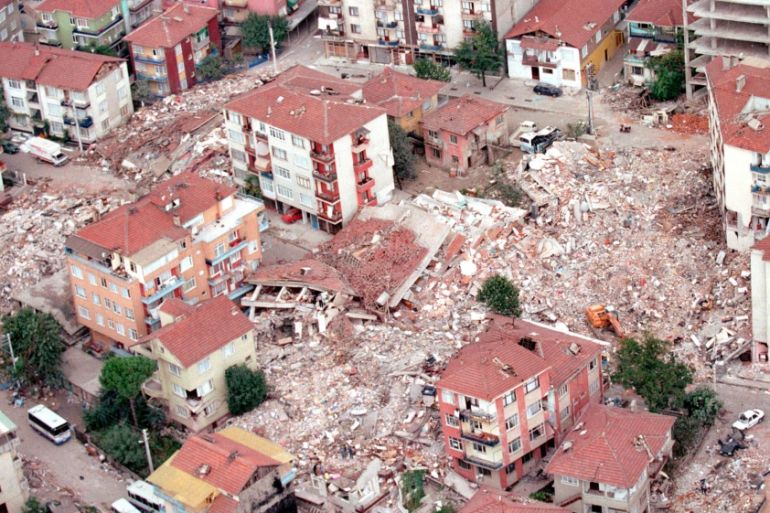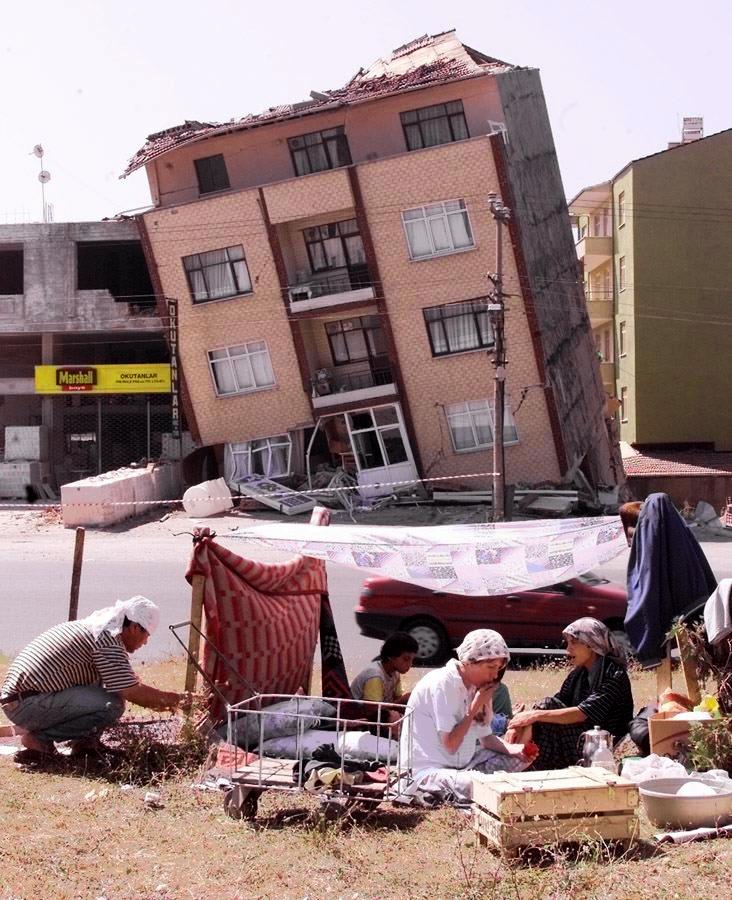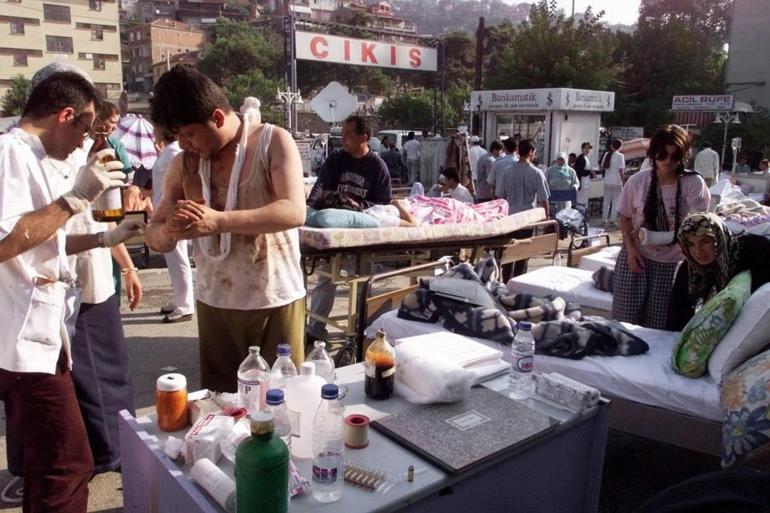How town at the epicentre of Turkey’s 1999 earthquake was rebuilt
As Turkey reels from last month’s devastating earthquakes, the reconstruction of Golcuk could offer glimpse into what needs to be done now.

Golcuk, Turkey – Life is breezy in this corner of northwestern Turkey, simple and unhurried. Families live mostly in low-rise homes and stroll in large green areas overlooking the waters of the Marmara Sea. Roads are modern and the public infrastructure is brand-new.
But it was not always like this. In August 1999, the small town of Golcuk was the epicentre of a magnitude-7.4 earthquake that rocked Kocaeli province and the wider Marmara area. Thousands of buildings crumbled like sandcastles and more than 17,000 people died across the region.
Keep reading
list of 3 itemsSyrian refugees in Turkey face return to quake-stricken areas
Death toll climbs above 50,000 after Turkey, Syria earthquakes
The devastation, however, was followed by a systematic reconstruction process that has since transformed Golcuk into “the Paris of Kocaeli” – as some residents call it, with a touch of pride – and a perceived safe haven in a country that is regularly blighted by earthquake disasters.
The most recent was a month ago, when two powerful tremors killed nearly 50,000 people and wrecked tens of thousands of buildings across southern Turkey.
As the country seeks to process the latest tragedy, many believe that the rebuilding of Golcuk could offer a glimpse of what successful reconstruction in the affected southern cities may look like.
“We feel very secure living here,” said Baki Kotan, a Golcuk resident and survivor of the 1999 quake. “It was re-built so much better that it attracted new people and investors.”

The reconstruction
Less than an hour’s drive away from Istanbul, Kocaeli is Turkey’s industrial heartland. From the 1960s and onwards, it was a prime destination for people migrating from the rural east towards the more developed west. This created a huge demand for cheap housing. By 1999, the region accounted for a third of the county’s economic growth and 45 percent of its industrial capacity.
But then, at 3:01am on August 17 of that year, the earth began shaking.
The jolt lasted for less than a minute but the catastrophe was such that it took about three months to clear the rubble, recalled Ismail Baris, the then-mayor of Golcuk. A total of 15,000 buildings were destroyed in the town.
But as survivors grappled with the aftermath of the disaster, a post-quake recovery plan was swiftly set in motion. Inspectors began conducting soil testing, a practice that was not widely used before, to help them decide how to split the area into zones for residences and economic activities.
The result was a radical re-configuration of the town. Before the quake, construction was heavily concentrated closer to the sea, where profit was higher, but the soil was largely inappropriate due to its softness. “We had to move everybody from the north to the south,” Baris said, remembering it as a major challenge, along with the excavation on harder ground in the southern side.
The new structures were built under strict rules stipulating maximum heights of 3.5 floors and the use of stronger cement and thicker steel. The smaller size of the buildings meant that more of them were necessary to provide a roof to all those in need. This led to the identification of areas further afield that could accommodate the construction of new buildings. Today, these small permanent houses are mostly spread across the region, including on the mountains surrounding Izmit city, Kocaeli’s regional capital.
The housing construction rights were awarded via an international bidding process in which competitors had to meet specific standards, such as using a special design that would make houses resistant to a magnitude-8 earthquake. In other cases, especially in the rural areas where residents wanted to re-build their own houses, the Turkish government provided a three-phased finance programme.

Still, those stranded in shelters throughout the process needed cash. Ajay Chhibber, who was Turkey’s director of the World Bank when the quake hit in 1999, recalled noticing how families began splitting as men moved to Istanbul in search of jobs, while others started selling blankets and clothes that they had received as aid. “Even if you give them a tent and food, they still need cash to survive for a longer period of time without income,” said Chhibber, whose team set up a six-month cash assistance programme to get the local economy flowing.
The World Bank raised between $3bn and $4bn, said Chhibber, and helped create an earthquake insurance system to help encourage safe construction practices and reduce costs. To ease corruption concerns among donors, which included the Islamic Development Bank and the European Investment Bank, the World Bank pushed for the appointment of a state minister inside the prime minister’s office who became the institution’s main counterpart.
“By the end of 2004 the reconstruction was almost over,” Baris said. Some 8,200 buildings were constructed during that phase, with more in the years that followed. As a result, Golcuk’s pre-quake population of about 110,000 has since almost doubled.
Today, the government is eager to push ahead with reconstruction efforts in the 10 provinces hit by the February earthquakes. President Recep Tayyip Erdogan has promised to rebuild these areas within 12 months, but some are cautioning against a rush.
“It took us 2.5 years to finish and it was considered the fastest rebuilding process in the world,” Chhibber said of the effort after the 1999 tremor. “To try to do the same in one year you will have to cut a lot of corners,” he warned.
“They should do this more carefully as people who have been affected are so shaken up they don’t want to go back to unsafe buildings,” Chhibber said.
![[Virginia Pietromarchi/Al Jazeera]](/wp-content/uploads/2023/03/DSF2389.jpg?w=770&resize=770%2C513)
‘1999 taught us only on paper’
Golcuk is located some 1,000km (621 miles) away from Kahranmanmaras, the epicentre of last month’s magnitude-7.8 earthquake. But as soon as news of the far-away disaster spread in the town, the trauma of 1999 resurfaced again.
Kotan, the resident, said he has not watched television since February 6 to avoid reliving the ordeal. Others, like retired teacher Kemal Ekin, have said they have hardly gotten any sleep, tormented by a returning sense of unease over the inability to help people trapped in the debris. His wife, Sahsine Ekin, described a feeling of suffocation. “I feel as if I am [stuck] under rubble.”
The recent disaster has evoked similar feelings across the northwestern region, including in places where the destruction was not as bad as in Golcuk. In cities like Izmit, most damaged buildings were never renovated in accordance to the building codes, experts said. Hence, some are now rushing to seek guidance among trusted experts on how to inspect, strengthen or even rebuild their houses.
“Why do people call me?” asked Keramettin Gencturk, in-between answering phone calls and receiving people lining up inside his Izmit office. An imposing, nearly two-metre-tall engineer, Gencturk saw his popularity rise after none of the buildings he had constructed in the area collapsed in the 1999 earthquake.
“I don’t do too much. I just follow the rules!” he exclaimed, waving energetically the last edition of the 2018 earthquake building code.
Following the 1999 tremor, lawmakers introduced stronger building requirements, including mandatory building inspections and the use of better construction materials, such as steel and concrete.
But the comparison of striking similar accounts from the 1999 and 2023 earthquake disasters suggests that while the rules became stricter, their enforcement was not always consistent.

Reports from the 1999 quake speak of cement debris filled with so much sand that it could have crumbled by the touch of a hand. Other accounts describe steel rods inside columns too thin to comply with building code requirements.
Experts in recent weeks have also denounced the use of inferior construction materials, saying the poorly enforced regulations allowed people to take shortcuts. It was only in 2019 that the government appointed inspectors to check the construction process – before that, builders could employ the companies that were tasked with checking their structures, a practice that insiders say allowed deals behind closed doors. Multiple government amnesties, meanwhile, legalised thousands of buildings, clearing building code violators as long as they paid a fine.
“1999 taught us something, but [only] on paper,” Gencturk said.
Turkish authorities have, during the past month, launched an investigation against more than 600 people over the buildings that collapsed in the February 6 quakes, with 184 suspects jailed pending trial.
The World Bank has calculated that Turkey faces direct damages from the recent earthquakes worth $34.2bn – 4 percent of its gross domestic product in 2021. This is a conservative estimate as it does not include indirect or secondary impacts of the quake on the country’s economy, with the bank warning that reconstruction costs will be potentially twice as large.
Alper Dulger, head of the Izmit Chamber of Architects, said that fast and safe reconstruction was possible. The country has the manpower, the know-how and new construction technologies to build more secure compared with the 1990s, he added.
“We can manage this if we find the money,” Dulger said.
But the real challenge, he warned, was the return of old habits: “As long as people continue to expect that they can get away with amnesties, the loop will continue.”
![[Virginia Pietromarchi/Al Jazeera]](/wp-content/uploads/2023/03/DSF2394.jpg?w=770&resize=770%2C513)